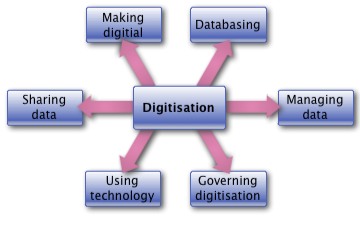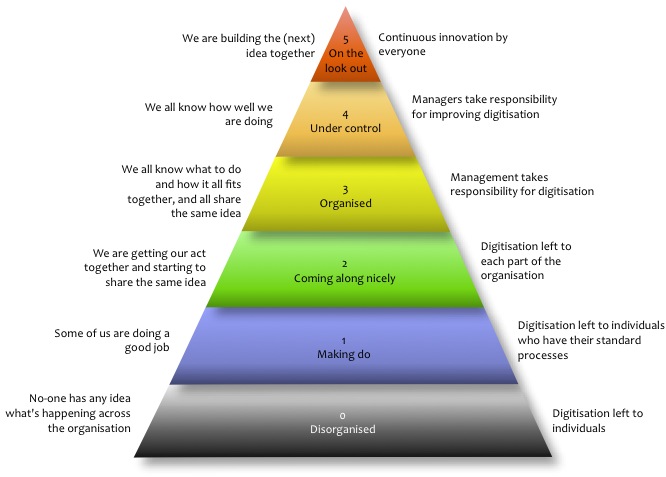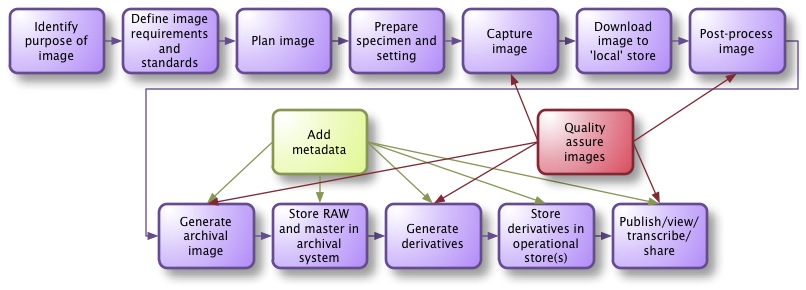The Atlas of Living Australia (Atlas) has access to biodiversity information only because the information is available in digital form. To assist data providers create and manage digital data, the Atlas has been cooperating with partners to produce a range of guidance on different aspects of digitisation.
See also Imaging Hints and Tips for information on a range of imaging topics.
What is digitisation?
Digitisation is essentially making a digital version of an object (eg specimen, work of art, photograph, analogue sound file, videotape), wrapping that version in metadata and making it available for sharing.
Core digitisation activities
Digitisation has six core activities:
- Making digital—creating a digital version of an object, sound file or other artefact
- Databasing—registering an object or artefact in a database; includes transcribing an artefact, eg transcribing a ledger into a database
- Managing data—providing for the long-term storage, accessibility and integrity of digital assets and databases
- Sharing data—making digital assets and data available for others to use; includes facilitating discovery of digital objects and data
- Using technology—adopting and using appropriate technology for digitisation activities
- Governing digitisation—establishing an appropriate governance framework to support digitisation

Digitisation process
The process of digitisation follows a five-step model:
- Plan for digitisation
- Organise digitisation activities
- Convert objects to digital format and database them and the digital object
- Mange the digital objects
- Share the digital objects and/or their metadata

Digitisation maturity model
To help you improve your digitisation activities you can use the digitisation maturity model. This model allows you to rate your ‘digitisation maturity’ on a scale of zero to five and explains the actions you need to take to improve that maturity against each of the core digitisation activities. Details of the model are given in Digitisation: A strategic approach for natural history collections [.pdf 9.3 MB].

Download:
- Digitisation seminar [.ppt 8.3 MB] for a presentation on the what, why and how of digitisation
- Digitisation: A strategic approach for natural history collections [.pdf 9.3 MB] for guidance on how to implement a strategic approach to digitisation. The guide provides advice on a range of digitisation topics including:
- an overview of the place of digitisation in natural history collections
- key concepts in managing digitisation
- major challenges in digitisation
- planning for digitisation
- organising digitisation
- the digitisation maturity model
- using volunteers in digitisation
This document is also available as an ebook from the Apple iBookstore.![]()
Imaging
Most Atlas partners have effective mechanisms to database their collections, but creating a digital image of a specimen or field note book or ledger has been a challenge because of limited resources or equipment.

To inform our support for imaging activities, the Atlas commissioned Dr Les Walkling to review the imaging needs of collecting institutions. In his report Digital Imaging Requirements Review[.pdf 759KB] Les talks about:
- the issues confronting institutions in their imaging activities the differences between institutions technical issues in imaging biodiversity collections the approaches that can be taken to implementing imaging technology.
- the issues confronting institutions in their imaging activities
- the differences between institutions
- technical issues in imaging biodiversity collections
- the approaches that can be taken to implementing imaging technology.
Following from this report, Atlas is developing a range of practical guidance to assist our partners and other data providers better image their collection:
Download Introduction to Resolution [.pdf 3.7MB] for an short introduction to digital resolution (courtesy of Dr Les Walkling).
Using volunteers for digitisation
About the project
The Australian Museum (AM) and South Australian Museum (SAMA), in association with the Atlas, have been exploring the use of volunteers to image and database specimens:
- AM volunteers imaged insects and their labels. Images are loaded into the Atlas’s volunteer portal from where crowd-sourced individuals transcribe the labels. Transcriptions will be loaded into the AM’s collection management system.
- SAMA uses volunteers to image and database type specimens. Database records will be loaded into the SAMA collection management system and the images shared with the Atlas.
As indicated in the final reports of the project, both exercises demonstrated the value of using volunteers to image and database specimens.
Download:
- Volunteer Project Final Report Cover Letter [.pdf 107KB]
- Australian Museum digitisation project final report [.pdf 1.8MB]
- South Australian Museum digitisation project final report [.pdf 779KB]
Documentation
Documents produced by the Australian Museum are available on their website and those from the South Australian museum on their site. All provide a basis for other institutions establishing a volunteer-based digitisation program.
Personal accounts
Read the personal accounts of those involved in this project: